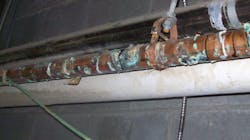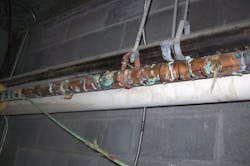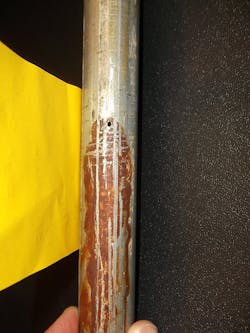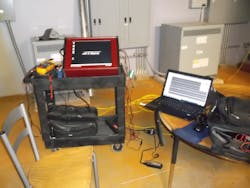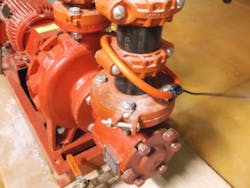By GARY R. GABRIEL, P.E., Johnson Controls, Roswell GA
While performing HVAC maintenance and repair work at several of our customer sites, we noticed something. At three jails, a school, and a factory, the metallic piping systems were suffering from a mysterious attack.
Specifically, most of the piping damage was in the form of pinhole leaks. Besides the immediate problem of dealing with water leaks, each customer was dismayed at the prospect of replacing each failed piping system. For example, at just one of the jails, alone, the piping system was required to be replaced at a cost of $800,000.
We researched pinhole leaks on the web and found a large and assorted collection of opinions, with little consensus. There were complaints of pinhole piping failures, including legal activity, for piping systems that were less than five years old.
In particular, the 1996 American Water Works Association (AWWA) Research Foundation Study was a great read: Effects of Electrical Grounding on Pipe Integrity and Shock Hazard. Also, Mike Holt’s 1997 Illustrated Guide to Bonding and Grounding is excellent reference material, complete with beautiful, true-to-life circuit diagrams.
Initially, we did spot measurements at each site with a handheld Volt Ohm Meter (VOM). It found Direct Current (DC) voltage on each damaged piping system, ranging between 0.5 volts DC to 0.9 volts DC. Later, our school customer paid $10,000 for professional testing to hunt down the DC voltage source.
The professional testing showed that the DC voltage on the piping systems was caused by even order harmonics.
By definition, even order harmonics are created by battery chargers or DC power supplies. Both of these contain diodes that convert the Alternating Current (AC) waveform to a DC waveform to create DC for each DC electrical load.
For example, a 4-diode rectifier flips half of the AC waveform to create DC, to put all of the waveform on one side of the null axis. In contrast, even order harmonics are created by a single diode rectifier, which orphans half of the AC waveform, converting just half of the AC waveform to DC. The orphaned half of the AC waveform creates even order harmonics, which is a non-symmetric, DC waveform, and the source of the DC voltage piping attack.
We observed that each electrical system was arranged to place the building piping systems in parallel with the electrical system, placing DC voltage on the piping systems as a parallel DC circuit.
Jails, in particular, are at high risk of pinhole piping leaks due to the 24-volt, DC door unlocking systems. Industrial customers can be at risk as well, particularly if exotic process-related electrical equipment creates a DC voltage threat for metallic piping systems.
Similarly, school DC voltage systems include the public address, fire alarm, and security systems, as well as the IT uninterruptible power supply (UPS), the emergency generator cranking system, and all of the laptop chargers.
Following the professional testing, remedial electrical grounding work was done at the school project. The result was to reduce the DC voltage on the piping systems from 0.9 volts DC to 0.3 volts DC. The 0.3 volts DC that remains is the DC voltage drop on the neutral between the indoor main service panel and the outdoor, pad-mounted utility transformer.
Conclusion
If a commercial or industrial project is still in the design phase, the engineer has two choices:
Option #1: Design the electrical systems so that the indoor metallic piping systems are minimized as a parallel DC pathway; or
Option #2: Go with nonmetallic (plastic) piping systems.
In contrast, if the project in question is already built, and pinhole leaks have started to show up, then you may still try to save the piping system from total destruction. For example, after DC voltage testing is done, provide electrical system remediation to reduce each piping system as a parallel DC pathway.
###########
Now in his ninth year with Johnson Controls, the author is a mechanical engineer and project development executive with three decades of HVAC, plumbing, and fire protection experience. He can be contacted at [email protected].
